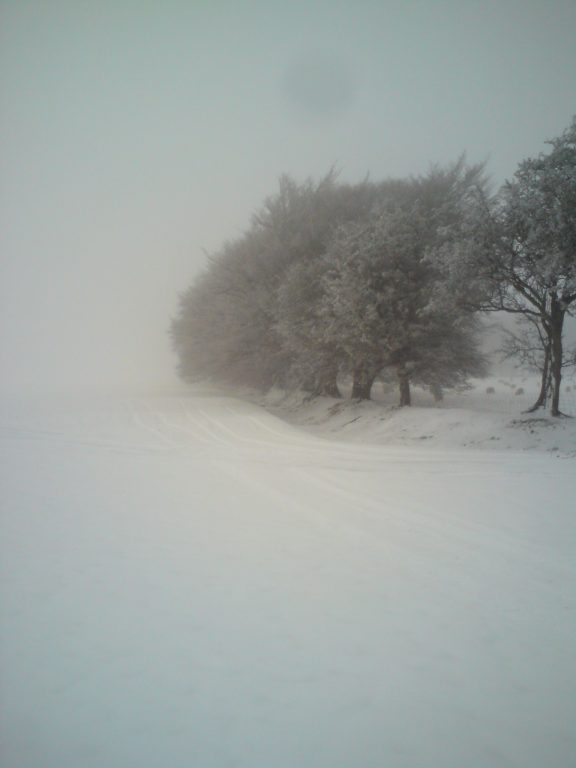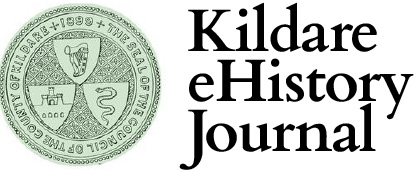Rathbride Fox Covert

Rathbride Fox Covert, pictured above by the author during the ‘Big Freeze’ of 2010, is a rectangular stand of mature beech and hawthorn trees. It will be a familiar sight to anyone who has travelled from the Curragh Racecourse along the R413 road, into Kildare Town. It is shown in the 1910/1911 Ordinance Survey 6″/1 Mile map. The inception of this covert is described in detail by The Earl Of Mayo in his book History Of The Kildare Hunt: “Mr Medlicott … replied: ‘If we could get permission from the Government to enclose a bit of ground on the Curragh, I know a great many farmers and tradesmen, all with horses, though they never see hounds, but are still good sportsmen, and I should be able to get a subscription among them to do it’ Lord Naas soon got the requisite permission from the Government and Mr Medlicott found no difficulty in raising the money. He was allowed to enclose eight acres altogether…”
Contemporary newspapers had regular reports on the hunt: ‘On Tuesday last there was a very good run from Sheshoon, where in a piece of gorse a hare was found. On through Maddenstown, over Mr. Kelly’s farm, through Mr. Ryan’s, over the big jumps of Tully, and was facing for Silliot Hill, when the hare was headed, turned slightly to the road through Mr. Lee’s farm, and on by the railway to Melitta Lodge, where they crossed the railway, passed through the gorse, had two rings round the fox covert and off to Rathbride, and a splendid run ended in a kill at Pollardstown bridge.’ ( The Leinster Express, January 23, 1875)
In one sense, this is an excellently written piece of prose which breathlessly records the events of the day. You can feel the adrenaline pumping through man and dog. The sounds of the baying hounds, mad for the kill, course through every clipped sentence. You can see the sunlight reflect off the sweaty brows of the mounted gentlemen, as they careen ever more recklessly over fences and hedgerows. There is an implicit compact between the dispatcher and audience, with no qualms over the eventual fate of the hunters’ quarry. Fox hunting is seen and portrayed as an exciting pastime. This, understandably, can seem jarring to the contemporary reader.
At one stage there were a huge number of fox coverts all around Ireland. Colin A. Lewis, in his definitive book Hunting In Ireland, details the genesis of this activity and the effects it had on the landscape and economy. Below is an image from Lewis’ book, showing how ubiquitous these structures once were in Kildare (reproduced here with kind permission from the author):
Contrary to what you might think, vast open, empty spaces were not conducive to fox hunting. As Lewis states, largely deforested, fenced in countryside, was actually preferred. Frenzied hounds were difficult to pursue through dense thickets. Originally, ‘…in a country where woodland, separated by stretches of largely unfenced open country predominated, there was little opportunity for riding across country: in any case there were few fences to jump, which must have detracted considerably from the sport’s excitement … With increasing destruction of woodland it became imperative that hounds should hunt in the open…’
The fox coverts dotted at intervals across the countryside, as in the image above, acted as ‘layover’ points during the course of the hunt. In an age of horsepower, and horse fatigue, the game was chased by the hounds, with riders in hot pursuit. As Lewis states, the fox coverts, interspersed at roughly two-mile intervals, gave the fox a temporary sanctuary and the horses and riders a chance to catch their breath before the game of cat and mouse started again.
The organisation of this activity had a hierarchical structure, as Lewis states: ‘The foundation of subscription packs, followed on horseback, started in the mid eighteenth century. Prior to this most hounds followed mounted had belonged to an individual…What normally happens is that the members guarantee the Master a set sum, which they raise through subscriptions and organized events…whilst the Master foots the remainder of the bill. Usually the Master pays heavily for his office.’
The popularity of fox hunting waxed and waned over the centuries, and was highly dependent on the cooperation of local landowners, whose fields could be crossed a number of times in one ‘season’. It was also affected by the political climate. Lewis remarks that: ‘During the 1800’s in particular there was a great deal of agrarian unrest in Ireland and this was partly directed against hunting. The mounted hunts were seen by many as the embodiment of landlordism and in some areas poison was laid for the hounds and followers were insulted and even attacked.’
Fox hunting experienced a precipitous decline in the twentieth century, for numerous reasons. In his book British & Irish Hunts & Huntsmen, JNP Watson gives his take on its demise: ‘Each year the enclosures get more wired up; sheep and cattle are on the increase; and annually, in 30 acre pockets, the Land Commission hand over large expanses to aspiring farmers from the non-agricultural and non-hunting west … the proliferation of smallholdings makes a Master’s liaison and public relations tasks far more complex and protracted than in the days when the country was in the hands of the substantial land owners’.
A walk around the perimeter of Rathbride Covert today, with the crunch of leaves underfoot and the wind soughing through the canopy above, gives little hint of its past.
By Kevin Dowling, Kildare County Archives and Local Studies.
Sources:
History Of The Kildare Hunt by The Earl Of Mayo & W.B. Boulton
The Leinster Express
1910/1911 Ordinance Survey 6″/1 Mile Map
Hunting In Ireland by Colin A. Lewis
British & Irish Hunts & Huntsmen by J.N.P. Watson
All of the resources used in this article are available to view, by appointment, in Local Studies.
